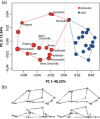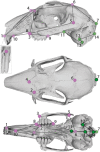Cranial shape variation in domestication: A pilot study on the case of rabbits
- PMID: 35934897
- PMCID: PMC9804214
- DOI: 10.1002/jez.b.23171
Cranial shape variation in domestication: A pilot study on the case of rabbits
Abstract
Domestication leads to phenotypic characteristics that have been described to be similar across species. However, this "domestication syndrome" has been subject to debate, related to a lack of evidence for certain characteristics in many species. Here we review diverse literature and provide new data on cranial shape changes due to domestication in the European rabbit (Oryctolagus cuniculus) as a preliminary case study, thus contributing novel evidence to the debate. We quantified cranial shape of 30 wild and domestic rabbits using micro-computed tomography scans and three-dimensional geometric morphometrics. The goal was to test (1) if the domesticates exhibit shorter and broader snouts, smaller teeth, and smaller braincases than their wild counterparts; (2) to what extent allometric scaling is responsible for cranial shape variation; (3) if there is evidence for more variation in the neural crest-derived parts of the cranium compared with those derived of the mesoderm, in accordance with the "neural crest hypothesis." Our own data are consistent with older literature records, suggesting that although there is evidence for some cranial characteristics of the "domestication syndrome" in rabbits, facial length is not reduced. In accordance with the "neural crest hypothesis," we found more shape variation in neural crest versus mesoderm-derived parts of the cranium. Within the domestic group, allometric scaling relationships of the snout, the braincase, and the teeth shed new light on ubiquitous patterns among related taxa. This study-albeit preliminary due to the limited sample size-adds to the growing evidence concerning nonuniform patterns associated with domestication.
Keywords: Oryctolagus cuniculus; allometry; cranium; modularity.
© 2022 The Authors. Journal of Experimental Zoology Part B: Molecular and Developmental Evolution Published by Wiley Periodicals LLC.
Conflict of interest statement
The authors declare no conflict of interest.
Figures





Similar articles
-
Modularity patterns in mammalian domestication: Assessing developmental hypotheses for diversification.Evol Lett. 2021 Jun 17;5(4):385-396. doi: 10.1002/evl3.231. eCollection 2021 Aug. Evol Lett. 2021. PMID: 34367663 Free PMC article.
-
Beyond CREA: Evolutionary patterns of non-allometric shape variation and divergence in a highly allometric clade of murine rodents.Ecol Evol. 2024 Jun 28;14(7):e11588. doi: 10.1002/ece3.11588. eCollection 2024 Jul. Ecol Evol. 2024. PMID: 38952651 Free PMC article.
-
New insights into the phenotypic covariance structure of the anthropoid cranium.J Anat. 2014 Dec;225(6):634-58. doi: 10.1111/joa.12246. Epub 2014 Nov 18. J Anat. 2014. PMID: 25406861 Free PMC article.
-
The mammalian brain under domestication: Discovering patterns after a century of old and new analyses.J Exp Zool B Mol Dev Evol. 2022 Dec;338(8):460-483. doi: 10.1002/jez.b.23105. Epub 2021 Nov 23. J Exp Zool B Mol Dev Evol. 2022. PMID: 34813150 Free PMC article. Review.
-
Rabbits - their domestication and molecular genetics of hair coat development and quality.Anim Genet. 2021 Feb;52(1):10-20. doi: 10.1111/age.13024. Epub 2020 Nov 20. Anim Genet. 2021. PMID: 33216407 Review.
Cited by
-
How (and why) languages became more complex as we evolved more prosocial: the human self-domestication view.Front Psychol. 2025 Jan 17;15:1499994. doi: 10.3389/fpsyg.2024.1499994. eCollection 2024. Front Psychol. 2025. PMID: 39895972 Free PMC article.
-
Developmental origin underlies evolutionary rate variation across the placental skull.Philos Trans R Soc Lond B Biol Sci. 2023 Jul 3;378(1880):20220083. doi: 10.1098/rstb.2022.0083. Epub 2023 May 15. Philos Trans R Soc Lond B Biol Sci. 2023. PMID: 37183904 Free PMC article.
-
From wild to domestic and in between: how domestication and feralization changed the morphology of rabbits.Proc Biol Sci. 2025 Jul;292(2050):20251150. doi: 10.1098/rspb.2025.1150. Epub 2025 Jul 2. Proc Biol Sci. 2025. PMID: 40592446 Free PMC article.
-
Cranial form differences in goats by breed and domestic status.Sci Rep. 2024 Jan 9;14(1):917. doi: 10.1038/s41598-023-50357-0. Sci Rep. 2024. PMID: 38195639 Free PMC article.
References
-
- Adams, D. C. , Collyer, M. L. , Kaliontzopoulou, A. , & Baken, E. K. 2022. Geomorph: Software for geometric morphometric analyses. R package version 4.0.2. https://cran.r-project.org/package=geomorph
-
- Balcarcel, A. , Sánchez‐Villagra, M. , Segura, V. , & Evin, A. (2021). Singular patterns of skull shape and brain size change in the domestication of South American camelids. Journal of Mammalogy, 102(1), 220–235.
-
- Bauchot, R. (1978). Encephalization in vertebrates. Brain, Behavior and Evolution, 15(1), 1–18. - PubMed
Publication types
MeSH terms
LinkOut - more resources
Full Text Sources

